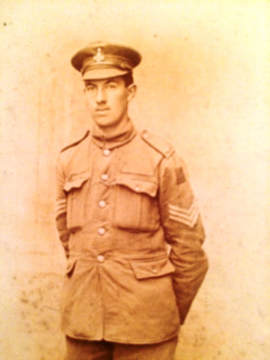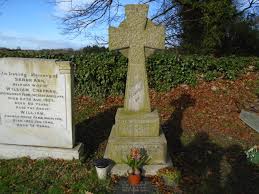 Note: The numbers in the square brackets refer to the references which are listed on the Sergeant Thomas Adamson Reference Page.
Note: The numbers in the square brackets refer to the references which are listed on the Sergeant Thomas Adamson Reference Page.
Thomas Vasey Adamson was born on 11th July 1894 at Field House, Hutton Fields Farm, Yorkshire [1][2]. This farm lies half a mile south-east of where the lane from Hutton Rudby to East Rounton crosses over the modern A19 dual carriageway. His father was Thomas Vasey Adamson, a farmer. His mother was Thomasine [4] Sarah Adamson, née Husband [1].
Thomas had 10 siblings [3].
By April 1911 the family had moved to Grinkle Carr Farm [3][16], which is half a mile north-west of Ingleby Arncliffe on the west side of the A19. Thomas was working for his father on the farm.
Thomas enlisted in Northallerton [5] as a Private in the 4th Battalion, Yorkshire Regiment. His service number was 6183 [23].
On 15th April 1915 he was serving in France [23]. By 1918 he had been promoted to the rank of Sergeant, and his service number had been changed to 200838 [5][23].
On 21st March 1918 the Germans launched their Spring offensive on the Western Front, aiming to defeat the Allied armies before American troops could arrive in significant numbers. The first attack fell on British lines east of Amiens aiming in the direction of the old battlefields of the Somme. Constrained by manpower shortages following the severe losses at Passchendaele the previous autumn, the British had arranged their forward defences in a series of strongpoints. After a short but extremely intense bombardment, specially trained German stormtroopers were able to infiltrate between them in the dense early morning fog. The British were soon forced into a fighting retreat in the face of the overwhelming numbers of German troops, many of them transferred from the Eastern Front after the Russians had signed an armistice in December 1917. The German advance in this sector was eventually brought to a halt by 5th April 1918.
On 26th March the 4th Battalion, Yorkshire Regiment withdrew from Ablaincourt through Lihoms to Rosières-en-Santerre, 19 miles south east of Amiens. The Battalion lost 15 Other Ranks killed in action during the day, including Sergeant Thomas Adamson [5] who only days before had returned to the front after being home on leave [6].
Percy Christon, a soldier of the 4th Battalion, recalled after the war that Sergeant Adamson “was a lovely lad, a good Sergeant. He looked after us very well and never let us down.” Percy was with him in a wood when he was shot through the head [7].

Sergeant Adamson died aged 23 after almost 3 years of active service on the Western Front. He was single when he died [7][9][15b].
In May 1918 Sergeant Adamson was reported in the Green Howards’ Gazette as missing. In June 1918 the Gazette stated that the German government had reported that he had been killed or died of wounds. In August 1918 the Gazette confirmed that he had been killed in action [8].
In the Army Register of Personal Effects Sergeant Adamson was listed as either Killed in Action or Died of Wounds [9]. This entry was made in January 1919.
Photographs of the cemetery and Sergeant Adamson's grave, taken on 20th September 2018, can be found on the Memorial Visits page on this website.
Possibly by July 1919 [10], and certainly by February 1921[12], his body had been exhumed from its resting place beside the remains of a small wood adjacent to the main road to Amiens, about 10 miles west of Rosières-en-Santerre [10][11][22]. His body was re-buried 3 miles to the south-west in Moreuil Communal Cemetery Allied Extension which is 11 miles south-east of Amiens [10][12][13][14][15][16][17][22].
The bodies of five other soldiers were exhumed from graves near his [10][11] and re-buried in Moreuil Communal Cemetery Allied Extension. Perhaps a Dressing Station had been located near the site of the wood, to where the men had been evacuated wounded from the front line but had subsequently died.
.jpg)
Sergeant Adamson is commemorated on a plaque inside All Saints Church, Ingleby Cross. It states that he was buried in Beaucourt Military Cemetery[18]. However, whilst researching this biography in early 2017 no record was found of Sergeant Thomas Adamson’s body having been in Beaucourt British Cemetery. The cemetery was created in August 1918 following fierce fighting to recapture the area from the Germans[19]. It lies about 6 miles west of Rosières-en-Santerre and 4 miles east of the wood that Sergeant Adamson’s body was exhumed from [20][21][22].
Note that Sergeant Adamson’s Battalion remained at Rosières-en-Santerre during 27th March. On 28th March, the Battalion withdrew south to Vrely, then north west to Caix, and then south west to Villers Aux Erables (which is 2 miles west of Beaucourt-en-Santerre). Their route may have taken them through Beaucourt-en-Santerre [5][22].
Regimental and brigade war diaries may have been written several days after a battle, based on information that had been pieced together. In a retreat, a soldier could have been killed anywhere on that day’s route, and buried nearby; and on plus or minus a day to the date quoted in the war diary. (Source: G Riordan)
Was Sergeant Adamson fatally wounded during the retreat on 28th March, leading to the confusion that he was buried at Beaucourt-en-Santerre?
He was awarded the following medals: the 1914-15 Star, the British War Medal, 1914-18, and the Allied Victory Medal [23][24][25]. They are in the care of his nephew Tom Rudd, along with his Memorial Scroll and Memorial Plaque [26][27][28][29][30].